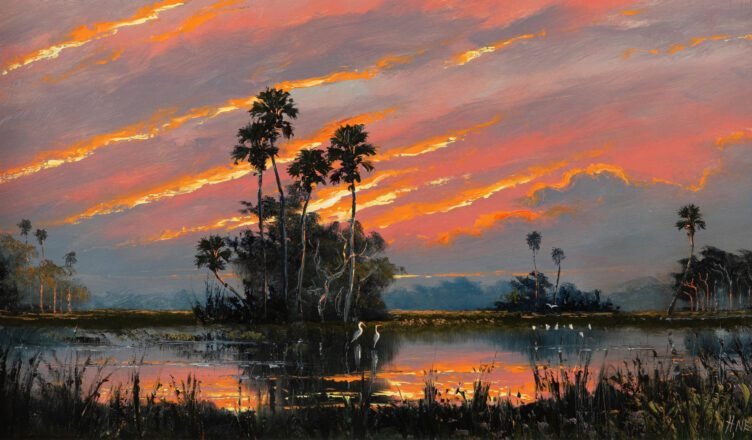They peddled their art from the trunks of cars for as little as $20 a pop. Often the paint had barely dried on these bright and breezy Florida landscapes, with clouds as brilliant as tangerines mirrored in swampy turquoise lakes – a color scheme that intentionally matched the decor of family rooms in the 1960s.
Critics sniffed this was merely motel art.
Still, these landscapes by a group of African Americans in Florida – christened the Highwaymen by a Florida collector in 1994 – were enormously popular in the late 1950s and throughout the ’60s. Highwaymen art later fell on hard times, spending at least two decades as fodder for garage sales and thrift shops and being dismissed as kissing cousins to velvet paintings of orchid-strewn jungles.
But in the past few years, it has become popular once more, perhaps another example of the growing taste for so-called “outsider” art. It now commands much higher prices and is marketed on the Internet instead of on two-lane state roads and small-town main streets.
In The Highwaymen: Florida’s African-American Landscape Painters (University Press of Florida, $29.95), author Gary Monroe tells the remarkable story of these largely self-taught artists. He has identified a core group of 26 artists who lived in black neighborhoods of Fort Pierce and Vero Beach. They plied their trade in the era before interstate travel to Disney World gobbled up their distribution points and made their product look dated.
It was a good living, more satisfying than working in the orange groves or packinghouses around Fort Pierce, where many of the artists in this loosely affiliated group lived.
Monroe’s book is a valuable document of one little-examined chapter of Florida’s rich cultural past, showing how black artists contributed to the dreamy visions of Florida that were being aggressively marketed at a time when air conditioning and mosquito repellent in the 1950s made the state a desirable destination.
It’s no wonder that many of the artists’ customers were real estate agents.
Gallery representation was virtually unheard of for black artists then, so the Highwaymen effectively short-circuited the gallery system, and their distinctive imagery reflected that tenacity.
This was frankly commercial, fast-buck art, with Alfred Hair, one of the best-known Highwaymen, turning out as many as 40 paintings in a day. Materials were cheap and readily available: Upson board, a roofing material, doubled as a canvas, while tree trunks served as impromptu easels and finished paintings were framed with crown molding.
But the work was also characterized by an unpretentious freshness as artists developed styles that were clearly their own and far different from that of their mentor, A.E. “Beanie” Backus of Fort Pierce.
As illustrations in Monroe’s book reveal, clouds ballooned over shorelines with forthright majesty. Slapdash strokes of paint filled out sunset-bathed palms bending in the wind and herons flocking to cypress trees – all with an immediacy that was accessible and vivid.
Few cars, motels or people clog up the Edenic fantasy views, and in this work there’s not a speck of irony.
Monroe traces the group’s beginnings to the mid-1950s, when Harold Newton and Hair became friendly with Backus, who had already achieved fame for his classic Florida landscapes. Newton was a young artist who had found some success selling his work on the street. A local art teacher steered the more flamboyant Hair, destined to become the group’s leader, to Backus’ studio.
More artists followed, but since this group would have to find its own market quickly to make the artist’s life pay, Hair showed that success was possible if their paintbrushes were fleet.
Drawing on nearly two dozen interviews with Highwaymen
and with Mary Ann Carroll, apparently the sole Highwaywoman, Monroe paints a picture of art produced at a frenetic, but fun-filled, pace. Work was sometimes done at all-night parties where beer and barbecue were plentiful, though not every artist felt compelled to match Hair’s speed.
Much of the group’s energy dissipated when Hair was shot, at age 29, during a barroom brawl in Fort Pierce in 1970. By the 1980s, fewer Highwaymen were still making art. By then, Monroe reports, the work had become a slick caricature of its former spontaneous self, overly indebted to tourist brochures or even to Backus’ paintings.
Very much a unique product of a particular time and place, Highwaymen art yielded, as Carroll says with an eloquence as simple as the paintings themselves, “an honest dollar for an honest day’s work.”


